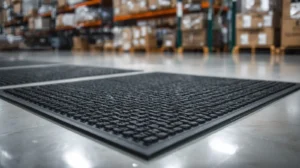Electricity is the lifeblood of modern industry, powering everything from heavy machinery to delicate control systems. While it drives productivity, it also presents significant safety hazards. Protecting personnel from high-voltage electrical shocks is not just a priority—it is a mandatory requirement. This is where Electrical Insulating Mats play a crucial role. These specialized rubber mats act as a vital line of defense, ensuring worker safety in high-risk electrical environments.
This guide will explore everything you need to know about Electrical Insulation Rubber Mats. We will cover why they are essential, how to choose the right one, and what makes high-quality electrical mats a non-negotiable investment. Whether you are a plant manager, safety officer, or an engineer, understanding the function and value of an electrical safety mat is fundamental to creating a secure workplace.
Table of Contents
ToggleWhat Exactly Are Electrical Insulating Mats?
An electrical insulator is any material that resists the flow of electric current. Electrical Insulating Mats, also known as dielectric carpets or switchboard matting, are specifically engineered floor coverings made from dielectric elastomer compounds. Their primary purpose is to insulate workers from the ground, preventing the completion of an electrical circuit through their bodies should they come into contact with a live conductor.
These are not ordinary rubber mats. They are manufactured and tested to meet strict national and international safety standards, such as IS:15652, IEC 61111, and ASTM D178. This ensures they can withstand specific voltage levels without breaking down. Using a certified electrical safety mat in front of switchboards, high-voltage panels, and other electrical apparatus is a standard safety protocol across countless industries.
Why Are High-Quality Electrical Mats Essential for Workplace Safety?

Investing in high-quality electrical mats is an investment in human life and operational continuity. In environments with high-voltage equipment, the risk of an electrical accident is always present. A momentary lapse in concentration or an unexpected equipment fault can have fatal consequences.
Here’s why these mats are indispensable:
- Primary Protection Against Electric Shock: The human body is a conductor of electricity. An electrical safety mat provides a high-resistance barrier between the worker and the ground, interrupting the path for current to flow. This insulation can be the difference between a minor incident and a fatal electrocution.
- Compliance with Safety Regulations: Regulatory bodies worldwide mandate the use of personal protective equipment (PPE) in electrical work environments. Electrical rubber mats are a key component of this requirement. Using certified mats helps your facility remain compliant and avoid hefty fines or legal action.
- Building a Culture of Safety: Providing the right safety equipment demonstrates a company’s commitment to its employees’ well-being. It fosters a culture where safety is prioritized, which can lead to increased morale and productivity.
Key Features to Look for in Electrical Rubber Mats
When sourcing from electrical insulation mat suppliers, it’s crucial to understand the features that define a superior product. Not all electrical mats are created equal. Here are the characteristics of high-quality electrical mats that ensure reliable performance.
- High Dielectric Strength: This is the most critical feature. It measures the maximum electric field strength a mat can withstand before it breaks down and starts conducting electricity. A good mat will have a dielectric strength far exceeding its intended use voltage.
- Compliance with Standards: Look for mats that are explicitly marked as compliant with IS:15652, IEC 61111, or ASTM D178. These standards guarantee the mat has passed rigorous testing for voltage, leakage current, and durability.
- Fire Retardancy: In case of an electrical fire, the mat should not contribute to the blaze. Fire-retardant properties are essential for containing hazards.
- Resistance to Contaminants: Industrial environments often expose equipment to oils, acids, alkalis, and other chemicals. A durable electrical insulator mat will be resistant to these substances, ensuring its insulating properties are not compromised over time.
- Mechanical Strength: The mat should have high tensile strength and elongation properties to resist tearing, punctures, and daily wear and tear from foot traffic and equipment movement.
- Low Leakage Current: Even the best insulators allow a tiny amount of current to pass through. For an electrical safety mat, this leakage current must be exceptionally low (typically less than 1mA) to be considered safe.
- Textured Surface: A non-slip top surface provides better grip, reducing the risk of slips and falls, especially in areas that may be wet or oily.
Understanding Voltage Classifications: Choosing the Right Mat

Electrical Insulation Rubber Mats are categorized into different classes based on the maximum voltage they are designed to protect against. Selecting the correct class for your application is non-negotiable. Using an underrated mat can provide a false sense of security and lead to catastrophic failure.
Here is a common breakdown of voltage classes based on IS:15652:
- Class A:
- Max Use Voltage: 3.3 kV
- Thickness: 2.0mm
- Application: Suitable for low-voltage panels and switchboards.
- Class B:
- Max Use Voltage: 11 kV
- Thickness: 2.5mm
- Application: Commonly used in front of 11kV panels, substations, and industrial control rooms.
- Class C:
- Max Use Voltage: 33 kV
- Thickness: 3.0mm
- Application: Designed for high-voltage applications, including power generation plants, large industrial facilities, and transmission substations.
- Class D:
- Max Use Voltage: 66 kV
- Thickness: 3.5mm
- Application: For extra high-voltage environments, providing the highest level of protection.
Always assess the maximum potential voltage in the work area and select a mat with a voltage rating that comfortably exceeds it. When in doubt, it is always safer to choose a higher-class mat.
Finding the Best Electrical Rubber Mat Prices

When searching for the best electrical rubber mat prices, it’s important to balance cost with quality. The electrical insulated rubber mats price can vary significantly based on the manufacturer, certification, class, and material quality. While it might be tempting to opt for the cheapest option, compromising on safety is a risk not worth taking.
Here’s how to find value:
- Source from Reputable Manufacturers: Look for established electrical insulating mats manufacturers, especially electrical insulating mats manufacturers in India, who have a proven track record of quality and compliance. They are more likely to offer reliable products.
- Request Test Certificates: Legitimate electrical insulation mat suppliers will readily provide type test reports and certificates from accredited labs (like ERDA or CPRI in India). This documentation verifies the mat’s performance claims.
- Compare Specifications: When comparing the electrical insulating mat price from different suppliers, ensure you are comparing products with the same class, thickness, and certifications.
- Consider Longevity: A higher initial price for a durable, high-quality mat can result in a lower total cost of ownership, as it will last longer and require less frequent replacement.
Proper Use, Care, and Maintenance of Your Electrical Mats
To ensure your electrical safety mat provides continuous protection, it must be properly maintained. Neglect can degrade its insulating properties and render it unsafe.
Installation and Use
- Place the mat on a clean, dry, and flat surface.
- Ensure the mat covers the entire working area in front of the electrical equipment.
- Do not cover the mat with other objects or unrated floor coverings.
- The mat should lie flat without any curls or folds that could create a tripping hazard.
Inspection and Cleaning
- Regular Visual Inspection: Before each use, visually inspect the mat for cuts, tears, punctures, embedded metal shavings, or signs of swelling or discoloration. Any damage compromises its integrity, and the mat should be immediately removed from service.
- Periodic Electrical Testing: Depending on regulations and company policy, mats should be periodically re-tested to verify their dielectric properties.
- Cleaning: Clean the mats with a mild soap and water solution. Avoid using petroleum-based solvents or harsh chemical cleaners that can degrade the rubber. Ensure the mat is completely dry before putting it back in service.
Storage
- When not in use, store electrical rubber mats in a clean, dry area away from direct sunlight, extreme temperatures, and UV sources.
- Store them flat or rolled. Avoid folding or creasing the mats, as this can create weak points in the material.
Conclusion: Make Safety Your Top Priority
Electrical Insulating Mats are more than just a piece of equipment; they are a life-saving tool and a cornerstone of any effective electrical safety program. From low-voltage panels to high-voltage switchgear, these mats provide the essential insulation that protects your most valuable asset—your people.
By understanding the key features, choosing the correct voltage class, and sourcing from reputable electrical insulating mats manufacturers, you can ensure your workplace is equipped with reliable protection. Remember that the electrical insulated rubber mats price is a small cost compared to the devastating consequences of an electrical accident. Prioritize quality, follow maintenance guidelines, and empower your team to work safely and confidently.
Frequently Asked Questions (FAQs)
What are Electrical Insulating Mats?
Electrical insulating mats are specially designed rubber mats that protect workers from electric shocks. They act as insulators between the ground and the worker, preventing current from passing through the body in case of accidental contact with a live electrical source.
Why are Electrical Insulating Mats important for workplace safety?
These mats are essential because they provide the first line of defense against electrical hazards. They help prevent electrocution, ensure compliance with safety standards, and build a culture of safety in industrial and commercial facilities.
What standards should Electrical Insulating Mats comply with?
High-quality mats must comply with IS:15652 (India), IEC 61111 (International), or ASTM D178 (USA) standards. These certifications ensure the mats can safely withstand specific voltage levels and meet global safety regulations.
How do I choose the right Electrical Insulating Mat for my workplace?
You should select the mat based on your equipment’s maximum working voltage:
- Class A: up to 3.3 kV
- Class B: up to 11 kV
- Class C: up to 33 kV
- Class D: up to 66 kV
Always choose a class that exceeds your equipment’s voltage rating for maximum safety.
What features should I look for in a high-quality Electrical Rubber Mat?
Look for these key features:
- High dielectric strength
- Fire-retardant properties
- Resistance to oil, acids, and chemicals
- Non-slip textured surface
- Low leakage current
- Mechanical durability and tensile strength
How often should Electrical Insulating Mats be tested or inspected?
Perform a visual inspection before every use and schedule periodic dielectric testing as per your company’s safety policy or local regulations to ensure the mats remain in good condition and meet insulation standards.
How should I clean and maintain Electrical Rubber Mats?
Clean the mats using mild soap and water, avoiding petroleum-based or harsh chemical cleaners. Always ensure the mats are completely dry before use. Regular maintenance helps extend the mat’s lifespan and preserve its insulating properties.
How should Electrical Mats be stored when not in use?
Store the mats flat or rolled, in a clean, dry area, away from direct sunlight, heat, or UV exposure. Avoid folding them, as creases can weaken the material over time.
What happens to the mat’s safety performance if it gets damaged?
Any visible cuts, punctures, burns, or swelling mean the mat’s insulating property is compromised. Immediately replace damaged mats—using a faulty one can lead to electrical accidents.
Can Electrical Insulating Mats be used outdoors?
Yes, but only if the mats are UV and weather resistant. For outdoor use, ensure the mat is certified for environmental durability and installed on a clean, level, and dry surface.
Why should I buy certified Electrical Insulating Mats from trusted manufacturers?
Certified mats undergo rigorous testing to meet safety standards. Purchasing from trusted manufacturers Rubber Hose India LLP ensures product reliability, authenticity of test certificates, and long-term safety assurance for your workforce.
